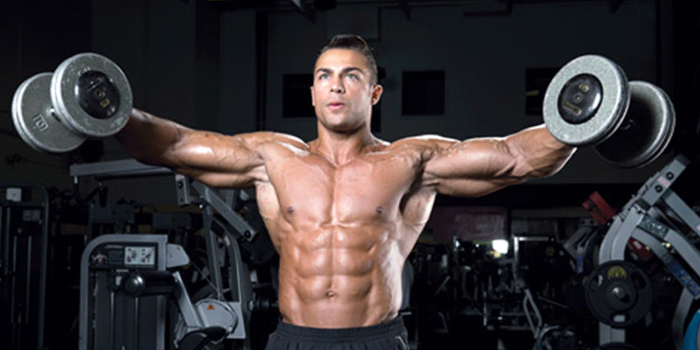Why Strong Shoulders Matter
The shoulders are one of the most prominent muscle groups when it comes to physique and function. They define the width of your upper body, play a crucial role in upper-body movements, and help maintain posture. When your shoulder workouts are effective and balanced, they not only contribute to a strong and athletic look but also support healthy joint mechanics and reduce the risk of injuries.
Many lifters, however, struggle to grow their shoulders due to poor programming or neglecting key movements. This guide walks you through ten shoulder workouts that are backed by training principles and genuinely help build muscle.
Understanding the Deltoids
To train the shoulders properly, it’s essential to understand the anatomy. The deltoid muscle is divided into three heads: the anterior (front), lateral (side), and posterior (rear). Each head plays a specific role in arm movement, and balanced training ensures complete development. Many people overtrain the front delts with pressing exercises and undertrain the rear delts, leading to imbalance and poor posture.
Key Principles for Shoulder Growth
Before diving into the actual shoulder workouts, it’s important to keep in mind some foundational training principles:
- Progressive Overload: Increasing weights, reps, or sets over time is essential for muscle growth.
- Training Volume: Your deltoids respond well to moderate-to-high volume training.
- Frequency: Training shoulders at least twice per week can yield better hypertrophy results.
- Form Over Ego: Proper form ensures muscle engagement and reduces injury risk.
- Recovery: Rest days and quality sleep are key to letting your muscles rebuild and grow.
Routine 1: Classic Dumbbell Shoulder Builder
A timeless routine that focuses on all three deltoid heads using dumbbells. It’s ideal for beginners and intermediates.
Exercises:
- Seated Dumbbell Overhead Press: 4×10
- Lateral Raise: 3×12
- Rear Delt Fly: 3×15
- Dumbbell Front Raise: 2×12
This shoulder workout gives balanced emphasis and is simple to perform at home or in the gym.
Routine 2: Barbell Power Press Day
For those looking to lift heavy and develop pressing power, this barbell-based shoulder workout delivers results.
Exercises:
- Standing Military Press: 5×5
- Push Press: 4×6
- Upright Barbell Row: 3×10
- Barbell Shrugs (bonus trap work): 3×12
Keep rest periods slightly longer and focus on controlled, heavy lifts.
Routine 3: Cable Isolation Circuit
Cables are great for maintaining constant tension on the muscles. This shoulder workout is great for developing muscle definition.
Exercises:
- Cable Front Raise: 3×15
- Single-arm Cable Lateral Raise: 3×12 per arm
- Reverse Cable Crossovers: 3×15
Use light to moderate weights and focus on slow, deliberate reps.
Routine 4: Rear Delt and Posture Focus
This is a must-do routine for anyone with rounded shoulders or desk posture. It prioritizes the rear delts, which are often undertrained.
Exercises:
- Face Pulls: 4×15
- Reverse Pec Deck Fly: 3×12
- Bent-over Reverse Raises: 3×15
- Band Pull-Aparts: 2×20
Stronger rear delts improve shoulder balance and prevent injury.
Routine 5: Home Shoulder Workout (No Equipment)
You don’t always need weights to train effectively. This bodyweight and resistance-band routine proves that.
Exercises:
- Pike Push-ups: 4×12
- Wall Angels: 3×20
- Resistance Band Lateral Raise: 3×15
- Shoulder Taps (core integrated): 3×30 seconds
Perfect for travelers or home workout days.
Routine 6: Volume Overload Shoulder Burn
A routine for advanced lifters looking to shock their delts with high volume and short rest.
Exercises:
- Arnold Press: 4×10
- Superset: Lateral Raise + Front Raise: 3×12 each
- Drop Set: Dumbbell Overhead Press: 3 sets
- Finisher: 50 Reps of Rear Delt Fly
Get ready to feel the burn with this high-fatigue shoulder workout.
Routine 7: Dumbbell Only Delts
If dumbbells are your go-to, this workout provides everything you need for full shoulder development.
Exercises:
- Arnold Press: 4×10
- Standing Lateral Raise: 4×12
- Incline Bench Rear Delt Fly: 3×15
- Dumbbell Front Raise: 3×12
Maintain strict form, especially on isolation lifts.
Routine 8: Athletic Shoulder Power
This workout blends functional strength and mobility. Ideal for athletes and active individuals.
Exercises:
- Landmine Press: 4×8
- Half-kneeling Dumbbell Press: 3×10
- Medicine Ball Slam: 3×12
- Band External Rotations: 2×15
It targets shoulder strength in dynamic movements while improving stability.
Routine 9: Giant Set Shoulder Shred
This is a time-efficient shoulder workout for those who want to push intensity and volume quickly.
Exercises (All performed back-to-back):
- Overhead Press: 10 reps
- Lateral Raise: 12 reps
- Rear Delt Raise: 15 reps
- Front Raise: 12 reps
- Repeat for 3 total rounds
No rest between exercises. Rest only after completing a full round.
Routine 10: Stability and Control
This routine emphasizes core integration and joint control, important for longevity in shoulder training.
Exercises:
- Single-arm Overhead Press: 4×10
- Stability Ball Lateral Raise: 3×12
- Turkish Get-Up: 2×5 per side
- Plank to Push-up: 3×30 seconds
It’s not just about lifting heavy; it’s also about control and coordination.
Tips for Long-Term Shoulder Growth
When progressing in your shoulder workouts, remember to prioritize form over weight. Focus on full range of motion and isolate each deltoid head properly. Start each workout with compound lifts like overhead presses, then move into isolations. Never skip rear delts, and stretch after every session.
Common Mistakes to Avoid
Many lifters make the mistake of letting momentum take over during lateral raises or going too heavy on isolation movements. Others overwork the front delts due to too much chest pressing. Poor posture, bad form, and neglecting mobility work can all lead to stagnation or injury.
Weekly Shoulder Split Example
To keep shoulder growth consistent, you can include two shoulder-focused sessions per week. Here’s a sample split:
- Monday: Push Day (includes overhead pressing)
- Thursday: Isolation Shoulder Focus (rear/lateral emphasis)
This structure allows enough recovery while still training delts effectively.
How Many Times Should You Train Shoulders Per Week?
For most people, training shoulders 1–2 times per week is ideal.
- Once a week is enough for maintenance or if you’re doing a full-body split.
- Twice a week works better for building mass or fixing weakness.
- Avoid overtraining — shoulders are involved in chest, back, and arm exercises too.
Focus on quality over quantity, giving muscles time to recover between sessions.

Can You Train Shoulders Without Weights?
Absolutely. You can train shoulders effectively using bodyweight exercises and resistance bands.
Some weight-free shoulder exercises include:
- Pike push-ups
- Wall walks
- Plank to downward dog
- Band lateral raises
These are great options if you’re at home, traveling, or just want to avoid weights.
How to Fix Shoulder Imbalance in Your Workout?
Shoulder imbalances are common and usually caused by poor posture or overtraining one side.
To fix this:
- Train each side unilaterally (e.g., single-arm dumbbell presses)
- Identify the weaker side and start with it
- Include more rear delt work to counteract front-dominant training
- Focus on form and control, not just weight
Correcting imbalance takes time, but consistency and awareness will bring balance back.
Why Do My Shoulders Hurt After a Workout?
Some soreness is normal, but sharp or lingering pain isn’t. Common causes include:
- Poor form during overhead movements
- Overloading too quickly
- Ignoring warm-ups and mobility
- Underdeveloped rotator cuff muscles
If the pain persists or worsens, consider taking a break, icing the area, and consulting a professional.
Shoulder Workout: Cables vs Dumbbells – Which Is Better?
Both tools are effective, but they serve different purposes:
Cables:
- Provide constant tension
- Great for isolating smaller muscles
- Safer for joints when used properly
Dumbbells:
- Build functional strength and stability
- Allow for free range of motion
- Better for compound lifts like overhead press
Best approach: Combine both. Use dumbbells for big lifts and cables for precision and finishing sets.
What’s the Difference Between Front Raise and Lateral Raise?
These two classic moves target different parts of your shoulders:
- Front Raise: Targets the anterior (front) deltoid
- Lateral Raise: Focuses on the medial (side) deltoid
For balanced development, include both in your routine — but don’t overdo front raises if your chest workouts already hit the front delts.
Can Push-Ups Build Shoulder Muscles?
Yes, but with limits.
Push-ups primarily target the chest and triceps, but they also engage the anterior deltoids. For full shoulder development, you’ll need to include specific shoulder exercises.
If you’re doing advanced variations like pike push-ups or handstand push-ups, you can build decent shoulder strength over time.
Why Do I Get Shoulder Pain After Chest Day?
This is a common issue and often due to:
- Poor push-up or bench press form
- Weak rotator cuff or stabilizer muscles
- Overworking front delts without balancing rear delts
Tip: Balance pushing exercises (like bench press) with pulling exercises (like rows or face pulls) to reduce strain and improve posture.
How to Warm Up Shoulders Before a Workout?
A proper warm-up can prevent injuries and boost performance.
Here’s a quick shoulder warm-up routine:
- Arm circles and swings – 30 seconds each direction
- Band pull-aparts or face pulls – 2 sets of 15 reps
- Light dumbbell or cable internal/external rotations
- Scapular push-ups or shoulder taps
Spend at least 5–10 minutes warming up before hitting your working sets.
Final Thoughts
Building strong, defined shoulders isn’t about randomly lifting weights. It’s about intentional training, targeting each deltoid head, and respecting your body’s need for recovery. These ten shoulder workouts are carefully designed to support real muscle growth and provide variation for different fitness levels and goals. Choose a couple routines and rotate them over time. With consistency, good form, and smart programming, your shoulders will become one of your strongest assets.
FAQs
How often should I do shoulder workouts for muscle growth?
Ideally, you should train your shoulders twice a week. One session can be focused on pressing movements and the other on isolation and rear delt work.
Do I need gym machines for effective shoulder workouts?
Not necessarily. Dumbbells, cables, resistance bands, and even bodyweight movements can build strong shoulders if done correctly.
Why are my rear delts not growing?
Most people neglect rear delt training or use poor form. Including face pulls, reverse flys, and specific rear-focused routines can help.
Can shoulder workouts improve posture?
Yes. Strengthening rear delts and improving shoulder mobility can reduce rounded shoulders and improve upper-body posture.
Is it okay to train shoulders with other muscle groups?
Absolutely. Shoulders pair well with chest or arms in a push-pull split, but ensure they’re not being overtrained from too much overlap.
